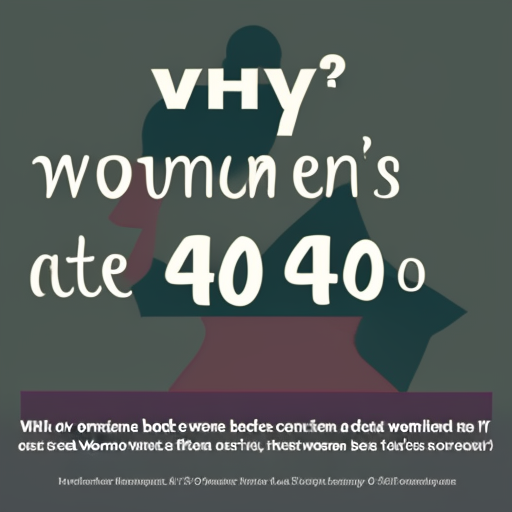As women approach their 40s, they often notice changes in their bodies that seemingly come out of nowhere. They may find themselves experiencing hot flashes, weight gain, decreased libido, and other frustrating symptoms. But why do these changes happen? Is it just a natural part of aging, or is there a deeper reason? In this article, we’ll explore the factors that contribute to women’s body changes after 40 and offer some tips for managing them. So buckle up, ladies, and let’s dive in.
Why Do Women’s Bodies Change After 40?
As women enter their 40s, they may start to notice some changes in their bodies that they never experienced before. Suddenly, it’s harder to lose weight, wrinkles seem to appear out of nowhere, and hot flashes become a regular occurrence. But why does this happen? One major factor is the hormonal changes that occur during perimenopause and menopause.
During perimenopause, which typically starts in a woman’s late 30s to early 40s, the levels of estrogen and progesterone (the hormones that regulate the menstrual cycle) start to fluctuate. This can lead to irregular periods, mood swings, and sleep disturbances. As menopause sets in and the ovaries stop producing as much estrogen, women may experience vaginal dryness, loss of bone density, and a slower metabolism. These changes can all contribute to weight gain, skin changes, and other shifts in the body. But it’s important to remember that every woman’s experience is unique and can vary greatly.
The Physiology of Ageing in Women’s Bodies
Women’s bodies go through several changes as they age, which can result in various health issues. Understanding is a crucial step towards managing these changes effectively. To start with, let’s discuss menopause. Menopause occurs when a woman’s ovaries stop producing estrogen, which results in the cessation of the menstrual cycle. This hormonal shift can cause a range of symptoms, such as hot flashes, night sweats, and mood swings. It’s essential to note that every woman’s experience with menopause is unique, and some may not experience any symptoms at all.
Another change that women’s bodies go through after 40 is lowered muscle mass. According to research, women start losing muscle density at a rate of 3-8% per decade after 30. This decrease in muscle mass is due to several factors, including less physical activity, hormonal shifts (such as a decrease in testosterone levels), and changes in diet. When muscle mass declines, women may experience more difficulty performing physical activities that were once easy, such as carrying groceries or climbing stairs. Therefore, maintaining an active lifestyle, including resistance training and cardiovascular exercise, is essential to retaining muscle mass and staying healthy.
Changes in Hormones and Metabolism
As we age, our bodies undergo significant changes, especially after hitting the 40s mark. Hormonal changes and metabolism play a crucial role in these transitions. During perimenopause and menopause, women’s bodies produce less estrogen and progesterone, leading to various changes.
One common change is weight gain, as the metabolism slows down. With the reduction of estrogen levels, the body redistributes fat to the belly area. Women may find it challenging to lose weight through diet and exercise, leading to frustration and self-doubt. However, it’s essential to understand that these changes are natural and not a reflection of one’s worth. In addition, women may experience mood swings, hot flashes, and night sweats due to hormonal fluctuations. Therefore, it’s essential to prioritize self-care and seek medical attention if necessary to manage these symptoms effectively.
The Impact of Lifestyle Choices on Women’s Bodies over 40
As we age, our bodies undergo numerous changes, both physically and hormonally. But did you know that the choices you make in your everyday life can greatly impact how these changes manifest? Take smoking, for instance. Not only can it cause premature aging and wrinkles, but it also increases the risk of heart disease and cancer. And for women over 40, the risk of these diseases can be even higher.
But it’s not just smoking that can affect our health. A sedentary lifestyle can also have a significant impact on our bodies. Lack of exercise can lead to weight gain, muscle loss, and even depression. On the other hand, regular physical activity can not only help us maintain a healthy weight, but it can also improve our mood, increase bone density, and reduce the risk of chronic diseases such as diabetes and heart disease.
- Smoking causes premature aging, wrinkles, heart disease, and cancer
- A sedentary lifestyle can lead to weight gain, muscle loss, and depression
- Regular physical activity can improve mood, increase bone density, and reduce the risk of chronic diseases
In conclusion, women’s bodies are amazing and complex, and while the changes that occur after 40 can be frustrating, they are completely normal. So, let’s embrace these changes and celebrate the strength and resilience of our bodies as we navigate this exciting new phase of life! Remember, age is just a number and there is no expiration date on feeling sexy, confident, and empowered. So, keep living your best life, ladies, and rock those changes with pride!